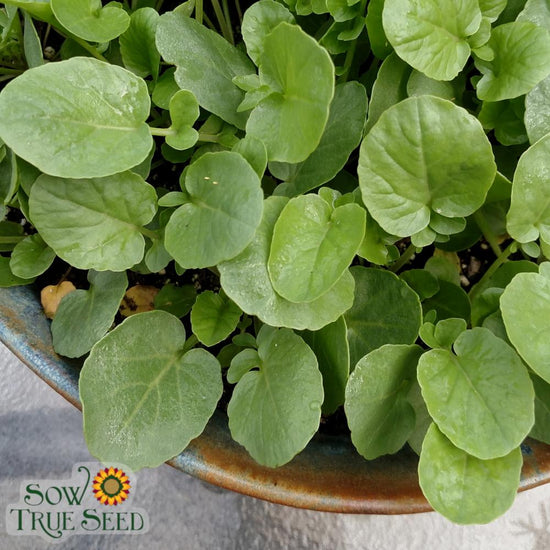What are Creasy Greens?
Creasy greens (Barbarea verna), which go by many names including highland cress, upland cress, and early yellow rocket are part of the Brassica family. “Brassicas you say?” Yes! These leafy greens are related to our garden staples like kale, broccoli, and cabbage. While their better-known relatives appear in the produce aisle, packaged in brightly labeled clamshells and on trendy restaurant menus, creasy greens reside, for the most part, in the memories of older Southern cooks and homesteaders. They are a plant that has been foraged and harvested for many decades in these mountains, providing early spring nutrients to people who lived here. And now their tangy and mustardy leaves, which are known for their myriad health benefits, are starting to make a comeback.
Where do Creasy Greens Grow?
Their lobed rosettes are one of the first plants to push up through the snow. Here, in Asheville, they can become visible as early as the first weeks of February and will persist through early May. They are found in moist but well-draining soils, unlike their distant cousin, watercress (Nasturtium officinale), which is a semi-aquatic plant found in the edges of streams. While they are native to Eurasia, they have naturalized over a long period of time and do not disturb native plants. They first arrived in North America as a cultivated species but have long since been replaced in the farmer's field by better-known greens like collards and arugula. Creasy greens now grow wild in almost all Eastern states and some Northwestern states. There is something comforting in knowing that this simple and giving plant has been growing all these years, waiting for us to come back to it and see its usefulness again.

How Should you Use Creasy Greens?
Creasy greens provide salad and cooking greens for home gardeners and foragers long before any other green makes an appearance in the spring. The greens are mainly used as cooking greens, added to soups and stews for a spicy kick! They make a delectable salad when drizzled with olive oil and apple cider vinegar or sauteed in butter or lard.
My Hunt for Creasy Greens
I began my search for creasy greens by looking in my own yard, but alas no luck. A friend sent me a picture from her yard that looked promising, but when I saw the plant in person it was another edible weed, not creasy greens. I reached out to another friend who works for No Taste Like Home edible food tours and she said they grow mainly in abandoned agricultural fields.
She took me on a foraging adventure, and we started by looking around an area she had seen them growing last year. Still no luck. We got talking about creasy greens and about wild food in general. She said creasy greens can be quite bitter if eaten raw but they are very good cooked. She pointed out that when we go out into nature looking for food we cannot expect to be offered exactly what we want when we want it and instead should open our minds to the possibilities that the wild opens for us.
I left with a bag full of chickweed and wild garlic mustard greens. There is something so alluring and delightful about foraging edible plants, especially after the long, cold months of a mountain winter. Eating something offered freely from the earth feels almost subversive, as if, just for a moment I exist outside of modern constraints.
How to Grow Creasy Greens
I didn’t want to give up on the chance to try creasy greens. So I cleared a small bed in my garden and sprinkled in some seeds. Creasy greens are easy to grow and can tolerate a wide range of soil conditions. But, they do require full sun and regular watering or rain. In late spring they send up tall flower stalks with abundant small yellow flowers that bees and other insects flock to. All parts of the plant are edible, including the flowers, stems, and seed pods. If they are left to flower they will reseed and provide greens every year. Though I am starting them late, they mature quickly, and within 50 days I should get my hands on some creasy greens.
Growing creasy greens is easy, just follow these tips!
- Seed in early fall or late winter, while the soil is cool and workable.
- Creasy greens can grow in full sun or part shade.
- They are highly tolerant of poor soils but will appreciate something well-draining.
- As your creasy greens patch is getting established, keep the area weeded.
This wild plant gives to us unconditionally, and in that spirit, we can do something to give back. We can plant creasy green seeds in our own yards and gardens in order to enjoy a tasty harvest every year without depleting natural supplies. This gives us the thrill of “foraging” in our own yards, as this plant will take care of itself, without much coaxing from us. Growing creasy greens and understanding a bit about their history also connects us to this place and to those who lived here before us, it helps us reweave ourselves into the tapestry of the living web we call the Appalachian mountains. And maybe it will inspire those of us who have become very domesticated to consider what it might be like to become, just a little, wilder.
| |
Article Written by: Angie Lavezzo |
|
About the Author: Angie Lavezzo is the former general manager of Sow True Seed. Beyond her professional role at Sow True, Angie's passion for gardening extends into personal hands-on experience, fostering plants and reaping bountiful harvests. |




